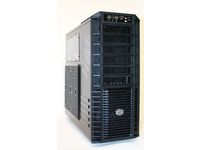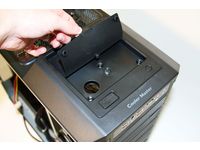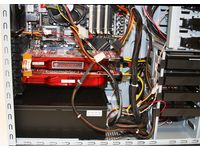Four Full Tower Cases From $150 To $600
Cooler Master HAF 932--Build And Installation
Build, Continued
The chassis’ interior is a pleasure to work in, as most of its steel edges are rolled to prevent cuts and scrapes. There’s even a hole cut in the non-removable motherboard tray. If you’re installing a Core i7 920 and using a heatsink like Thermalright’s Ultra 120 Extreme, simply pop off the right side panel and work under the CPU socket without having to pull the motherboard out. The problem with this, unfortunately, is that motherboard vendors aren’t universal in their respective layouts, so the feature won’t be useable on some platforms, like the Asus Rampage II Extreme featured in our testing.
Cooler Master’s full tower design means that there is plenty of room for hard disks and optical drives. The chassis takes up to five 3.5” hard drives in one cage and up to six 5.25” externally-accessible drives in a separate cage above that. A bundled adapter turns one 5.25” bay into a 3.5” slot for a floppy drive or card reader. Hard drives are installed toollessly, which is nice. But the power and I/O ports face to the right side of the case, meaning you’ll need to snake SATA and power cables through the motherboard tray in order to connect them.
Installation
The HAF 932 is able to take a lot of hardware. It’s one of the few towers that’ll accept an eATX motherboard. Plus, with five hard drive and six 5.25” drive bays, there’s copious room for expansion. And yet, if you’re installing a high-end configuration, you’ll likely feel cramped inside the case.
With our PC Power and Cooling power supply installed, there isn’t enough room at the bottom of the case to take a third double-wide graphics card. You’d need an EVGA X58 motherboard in order to fit a 3-way SLI setup here. Also, given the way that the auxiliary power connectors on the Radeon HD 4870s face, accessing front panel connectors, storage ports, and FireWire/USB headers at the bottom right-hand of your motherboard might be difficult. Make all of your motherboard connections before dropping in discrete cards.
Here’s the really tricky thing about the HAF 932, though. Configured as it is from the factory, the case is all set up for a water cooling setup. There’s a fill port up top, grommetted holes in the back of the chassis for running hose, and room for a radiator if you yank the top 230 mm fan—don’t worry, you aren’t likely to miss the airflow. Unbolt that plate up top and relocate your power supply, though, and the case’s floor suddenly get a lot roomier. In fact, a pair of vents at its bottom are already cut out for 120 mm intake fans.
Get Tom's Hardware's best news and in-depth reviews, straight to your inbox.
With its vents, window, and tasteful LED lighting, the HAF 932 is a chassis you’ll want to peek into. Plenty of nooks and crannies designed to help aid cable management make the case easy to organize for just that reason. Just bear in mind that gobs of airflow are enabled by large vents on almost every surface. If you have noisy hardware inside the HAF 932, large, low-speed fans aren’t going to help suppress the din.
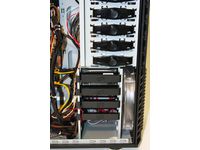
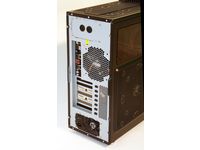
Current page: Cooler Master HAF 932--Build And Installation
Prev Page Cooler Master HAF 932--Unpacking And Build Next Page Thermaltake Spedo--Unpacking And Build-
Proximon Thank you Chris, another very useful article. Not enough case comparisons around, as I'm sure you realized.Reply
I'll be sure to add the HAF to my recommendation list. I hadn't before because I thought all the extra holes would hinder cooling more than help. The hole in the MB tray sounds especially useful.
I would have liked to see on of the Cosmos cases included, although I suspect they are simply quieter but hotter. -
malveaux Nice article.Reply
Though, I'm curious. 40db+ isn't whisper quiet. That's freak'n loud. What's up with calling it whisper quiet? -
Pei-chen The three cheaper cases are powerhouses but too big and overkill for most people including gamers. I think the Antec's Three Hundred ($60 a few weeks ago on Newegg) suits the need for most people. 750w PSU are usually enough for SLI/Crossfire so 1000w+ aren't needed.Reply -
malveaux I'm curious when they will start releaseing more cases that have more depth, so that they have more room for today's much larger videocard solutions.Reply -
kubes Ya I agree that case designers should consider making them have more depth. With this in mind though i'm sure vidoe card manufactors will only make their card even longer however.Reply -
antiacid Good article. Now it gives a procedure and template to test other cases as well. It'd be great to have a review of cases which could be "best of" a certain category (cooling, noise, ease of use, weight, etc). It would be even nicer if the results were put in bullet point form and were setup in a table like the ones used in hdd/video card tables. That would make it a lot easier to compare everything.Reply -
avatar_raq I do believe that all the cases available in the market these days are poorly designed especially when it comes to air flow. You may notice that front fans, rear fans, buttom, side and top panel fans -when combined- cause turbulence in air flow that reduces the overall air flow. That's why I buy a cheap $25 case and modded myself!!!Reply
I have so many innovations regarding case designs that I hope someone buys them and excutes them in reality!! -
avatar_raq Here is one of my ideas...Reply
To put it plainly: air needs to be moved in one direction, preferably from down-upwards, since hot air tends to go upward by nature and the hottest part of any system (that's the GFX cards) is located at the lower part..Hence a PSU mounted at the upper part of the case (with its 120-140mm fan), with another 120mm top-panel exhaust fan and two 120mm buttom intake fans will be by far more efficient than all the available cases. To achieve this efficincy I close any other holes (even the ones the manufacturer meant for ventilation) so the air enters the case only from the buttom fans where I put dust filters to minimize dust inside my case. Furthermore I use a case with long "legs" to minimize inhalation of the dust at my desk's surface.
To minimize noise: I use
1.low RPM silent fans.
2.rubber washers between the fans and the case to minimize vibration noise.
3.cover all the interior surfaces with a layer of an insulator, that can be as simple as sponge!!!
4.even design external air ducts that divert the exhausted air (which carries the interior noise) to the back. -
avatar_raq Fortunately many aftermarket CPU and GPU coolers helped me. They can be installed in a way that the fan moves the air upwards. There is evidence that the setup I suggested above reduces -though marginally- the power consumed by the CPU and GPU fans to reach thier designated rpm and increases the lifetime of these fans, since instead of meeting resistance, the one directional air flow helps them.Reply
